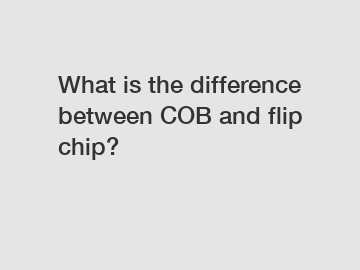What is the difference between COB and flip chip?
What is the Difference Between COB and Flip Chip?
In the world of electronics, there are various technologies and manufacturing techniques used to bring innovative products to life. Two popular options for connecting integrated circuits (ICs) to a substrate are Chip-on-Board (COB) and Flip Chip. While they both serve the same purpose of mounting ICs onto a substrate, there are significant differences between the two. In this article, we will explore the disparities between COB and Flip Chip technologies.
1. Chip-on-Board (COB).

COB technology involves directly attaching bare IC chips onto a printed circuit board (PCB) or another substrate. The IC chips are typically bonded and wire bonded in place, forming a permanent connection between the chip and the substrate. This technique allows for a compact design, as the IC chips are placed close to each other, minimizing the space required.
COB technology offers several advantages over other packaging methods. Firstly, it eliminates the need for a separate package and leadframe, reducing the overall size and weight of the device. Additionally, COB enables better thermal dissipation as the IC chips are in direct contact with the substrate, aiding in heat management. Moreover, the short interconnection length between IC chips and substrate reduces the parasitic capacitance and inductance, improving electrical performance.
2. Flip Chip.
Flip Chip, on the other hand, involves directly attaching the IC chips onto a substrate using solder bumps. Unlike COB, the IC chips in Flip Chip are flipped and mounted upside-down onto the substrate, allowing direct electrical connections. The solder bumps act as conductive connections between the IC chips and the substrate, ensuring reliable electrical pathways.
One of the key advantages of Flip Chip technology is its ability to achieve high-density interconnection. The small size of the solder bumps and the absence of wire bonds make it possible to pack a large number of IC chips onto a substrate, maximizing the functionality within a limited space. Flip Chip also exhibits better electrical performance as the solder bumps offer shorter interconnection lengths, reducing parasitic capacitance and inductance.
Furthermore, Flip Chip technology is known for its excellent thermal management capability. The direct contact between the IC chips and the substrate allows efficient dissipation of heat, preventing overheating and improving overall device reliability.
In conclusion, while COB and Flip Chip technologies both involve attaching IC chips onto a substrate, their methods and advantages differ significantly. COB technology offers a compact design, better thermal dissipation, and improved electrical performance, making it suitable for applications where space and heat management are crucial. In contrast, Flip Chip technology excels in achieving high-density interconnection, maximizing functionality within limited space, and providing efficient thermal management.
If you have any questions about COB or Flip Chip technologies, or if you are interested in incorporating these advanced packaging methods in your electronics projects, feel free to contact us. Our team of experts will be happy to assist you.
Are you interested in learning more about cob led chip, cob led array, high bright cob led chip? Contact us today to secure an expert consultation!


